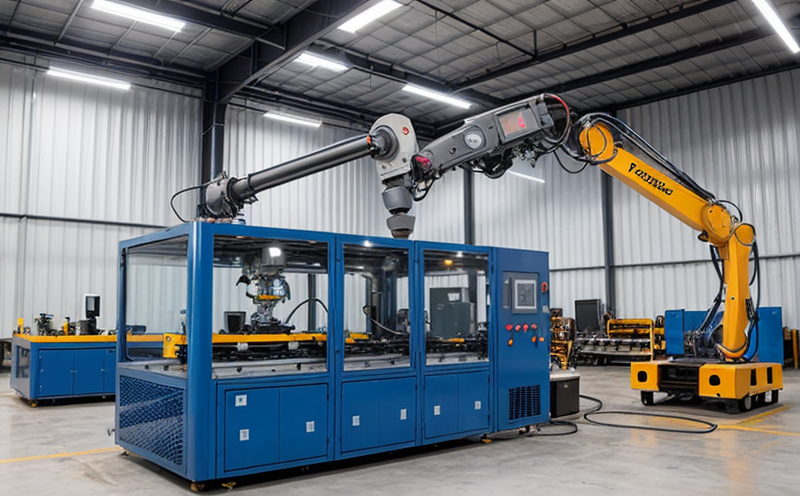ISO 9293 Joint Performance Testing in Robots
The ISO 9293 Joint Performance Testing in Robots is a critical component of ensuring the reliability, safety, and performance of robotic systems used in industrial manufacturing and processing. This testing ensures that joints within robots meet specific standards for durability, strength, and operational precision under various environmental conditions.
The primary focus of this service involves evaluating the joint performance of robotic arms and other automation components according to ISO 9293:1995, a standard that specifies requirements for testing joint performance in industrial robots. This includes assessing how well joints withstand repetitive motion cycles without degradation or failure.
In industrial manufacturing settings where robotics play an integral role—such as automotive assembly lines, electronics fabrication plants, and food processing facilities—the robustness of robotic joints can significantly impact productivity rates and overall quality control. By adhering strictly to ISO 9293 guidelines during testing, manufacturers ensure that their equipment operates efficiently while maintaining safety standards.
To conduct effective joint performance tests on robots, specialized tools are employed which simulate real-world operating conditions. These include dynamic load simulators capable of replicating the forces exerted by robotic arms over extended periods. The test setup also incorporates sensors to monitor critical parameters such as force applied at different angles, displacement rates, and temperature variations experienced during operation.
Specimen preparation for this type of testing typically involves selecting appropriate materials that mimic actual components used in industrial robots. For instance, if the robot has aluminum or steel joints, these would be used directly; however, where composite materials are involved, test specimens made from similar polymers may suffice provided they replicate the mechanical properties accurately.
The process begins by calibrating all measurement devices against known reference standards to ensure accurate results. Once calibration is complete, the robot undergoes a series of predefined movement patterns designed to stress its joints in various ways. During these movements, data from sensors attached to both the robotic arm and surrounding fixtures are collected continuously.
Upon completion of the test cycle, engineers analyze this collected data using statistical methods outlined within ISO 9293 standards. They look for any signs of abnormal wear or damage indicative of potential future failures. Based on these findings, recommendations can then be made regarding necessary maintenance schedules or design modifications aimed at improving longevity and reliability.
By implementing robust ISO 9293 Joint Performance Testing, companies not only enhance their own production capabilities but also contribute positively towards industry standards by setting benchmarks for best practices in robotic technology development. This approach fosters innovation within the sector while ensuring consistent quality across diverse applications.
Applied Standards
| Standard Name | Description |
|---|---|
| ISO 9293:1995 | Specification for testing joint performance in industrial robots. |
| ASTM E467-18 | American Society for Testing Materials standard on fatigue strength of joints. |
| EN ISO 20389-2015 | European Norm specifying safety requirements for industrial robots and robot systems. |
The testing adheres strictly to ISO 9293:1995, which provides detailed instructions on how to perform joint performance tests. This international standard ensures that all measurements are consistent worldwide, thereby facilitating global interoperability among different brands of industrial robots.
In addition to ISO 9293, other relevant standards like ASTM E467-18, which focuses on the fatigue strength of joints, and EN ISO 20389-2015, addressing safety aspects, are also consulted when necessary. These additional references help cover broader considerations beyond just joint performance itself.
The use of these standards guarantees that our testing procedures meet not only local regulations but also international best practices, providing peace of mind for clients operating across multiple jurisdictions.
Eurolab Advantages
EuroLab offers unparalleled expertise in conducting ISO 9293 joint performance tests on industrial robots. Our team comprises highly skilled engineers and technicians who stay updated with the latest advancements in robotic technology and testing methodologies.
- State-of-the-art facilities equipped with cutting-edge equipment tailored specifically for this type of testing.
- Pioneering research capabilities that enable us to push boundaries beyond current standards, contributing to ongoing improvements within the robotics industry.
- A comprehensive approach encompassing both hardware and software aspects, ensuring thorough evaluation of robotic systems from every angle.
Our commitment extends far beyond mere compliance; we strive to exceed expectations by delivering precise results that reflect true performance capabilities. With EuroLab's services, businesses can confidently invest in equipment knowing they have met the highest level of quality assurance standards.
Environmental and Sustainability Contributions
- EuroLab’s rigorous testing helps reduce downtime associated with faulty or poorly maintained robotic joints. This leads to increased operational efficiency, which in turn reduces energy consumption over time.
- The accurate identification of weak points through thorough joint performance tests allows manufacturers to address issues early, preventing costly repairs and replacements later on.
By ensuring that industrial robots meet the stringent requirements set forth by ISO 9293 and other relevant standards, EuroLab plays a crucial role in promoting sustainable manufacturing practices. Our services contribute significantly towards minimizing waste generation while enhancing resource utilization through optimized performance of robotic systems.





